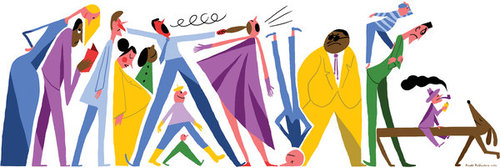
SOME years ago, executives at a Houston airport faced a troubling customer-relations issue. Passengers were lodging an inordinate number of complaints about the long waits at baggage claim. In response, the executives increased the number of baggage handlers working that shift. The plan worked: the average wait fell to eight minutes, well within industry benchmarks. But the complaints persisted.
Puzzled, the airport executives undertook a more careful, on-site analysis. They found that it took passengers a minute to walk from their arrival gates to baggage claim and seven more minutes to get their bags. Roughly 88 percent of their time, in other words, was spent standing around waiting for their bags.
So the airport decided on a new approach: instead of reducing wait times, it moved the arrival gates away from the main terminal and routed bags to the outermost carousel. Passengers now had to walk six times longer to get their bags. Complaints dropped to near zero.
This story hints at a general principle: the experience of waiting, whether for luggage or groceries, is defined only partly by the objective length of the wait. “Often the psychology of queuing is more important than the statistics of the wait itself,” notes the M.I.T. operations researcher Richard Larson, widely considered to be the world’s foremost expert on lines. Occupied time (walking to baggage claim) feels shorter than unoccupied time (standing at the carousel). Research on queuing has shown that, on average, people overestimate how long they’ve waited in a line by about 36 percent.
This is also why one finds mirrors next to elevators. The idea was born during the post-World War II boom, when the spread of high-rises led to complaints about elevator delays. The rationale behind the mirrors was similar to the one used at the Houston airport: give people something to occupy their time, and the wait will feel shorter. With the mirrors, people could check their hair or slyly ogle other passengers. And it worked: almost overnight, the complaints ceased.
The drudgery of unoccupied time also accounts in large measure for the popularity of impulse-buy items, which earn supermarkets about $5.5 billion annually. The tabloids and packs of gum offer relief from the agony of waiting.
Our expectations further affect how we feel about lines. Uncertainty magnifies the stress of waiting, while feedback in the form of expected wait times and explanations for delays improves the tenor of the experience.
And beating expectations buoys our mood. All else being equal, people who wait less than they anticipated leave happier than those who wait longer than expected. This is why Disney, the universally acknowledged master of applied queuing psychology, overestimates wait times for rides, so that its guests — never customers, always guests — are pleasantly surprised when they ascend Space Mountain ahead of schedule.
This is a powerful ploy because our memories of a queuing experience, to use an industry term, are strongly influenced by the final moments, according to research conducted by Ziv Carmon, a professor of marketing at the business school Insead, and the behavioral economist Daniel Kahneman. When a long wait ends on a happy note — the line speeds up, say — we tend to look back on it positively, even if we were miserable much of the time. Conversely, if negative emotions dominate in the final minutes, our retrospective audit of the process will skew toward cynicism, even if the experience as a whole was relatively painless.
Professors Carmon and Kahneman have also found that we are more concerned with how long a line is than how fast it’s moving. Given a choice between a slow-moving short line and a fast-moving long one, we will often opt for the former, even if the waits are identical. (This is why Disney hides the lengths of its lines by wrapping them around buildings and using serpentine queues.)
Perhaps the biggest influence on our feelings about lines, though, has to do with our perception of fairness. When it comes to lines, the universally acknowledged standard is first come first served: any deviation is, to most, a mark of iniquity and can lead to violent queue rage. Last month a man was stabbed at a Maryland post office by a fellow customer who mistakenly thought he’d cut in line. Professor Larson calls these unwelcome intrusions “slips” and “skips.”

Copyright © 2020 QueueRite.com. All Rights Reserved